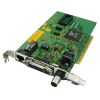
The BNC connector is used for RF signal connections, for analog and Serial Digital Interface video signals, amateur radio antenna connections, aviation electronics (avionics) and many other types of electronic test equipment. It is an alternative to the RCA connector when used for composite video on commercial video devices, although many consumer electronics devices with RCA jacks can be used with BNC-only commercial video equipment via a simple adapter. BNC connectors were commonly used on 10base2 thin Ethernet networks, both on cable interconnections and network cards, though these have largely been replaced by newer Ethernet devices whose wiring does not use coaxial cable. Some ARCNET networks use BNC-terminated coax.
BNC connectors exist in 50 and 75 ohm versions. Originally all were 50 ohm and were used with cables of other impedances, the small mismatch being negligible at lower frequencies. The 75 ohm types can sometimes be recognized by the reduced or absent dielectric in the mating ends. The different versions are designed to mate with each other, although the impedance mismatch in the cable may lead to signal reflections. Typically, they are specified for use at frequencies up to 4 and 2 GHz, respectively.
75 ohm BNC Connectors are primarily used for video applications whereas 50 ohm are used for data and RF. There was a convention in the BBC that BNC connectors used for video were always 50 ohm probably because a stray 50 ohm BNC plug would damage a 75 ohm socket if connected in error. Many VHF receivers used 75 ohm antenna inputs so often used 75 ohm BNC connectors.









